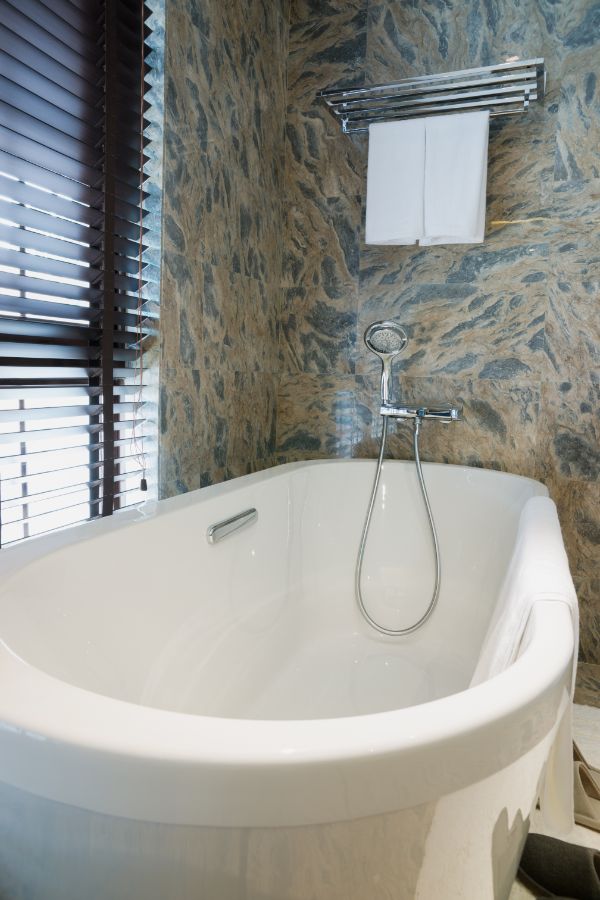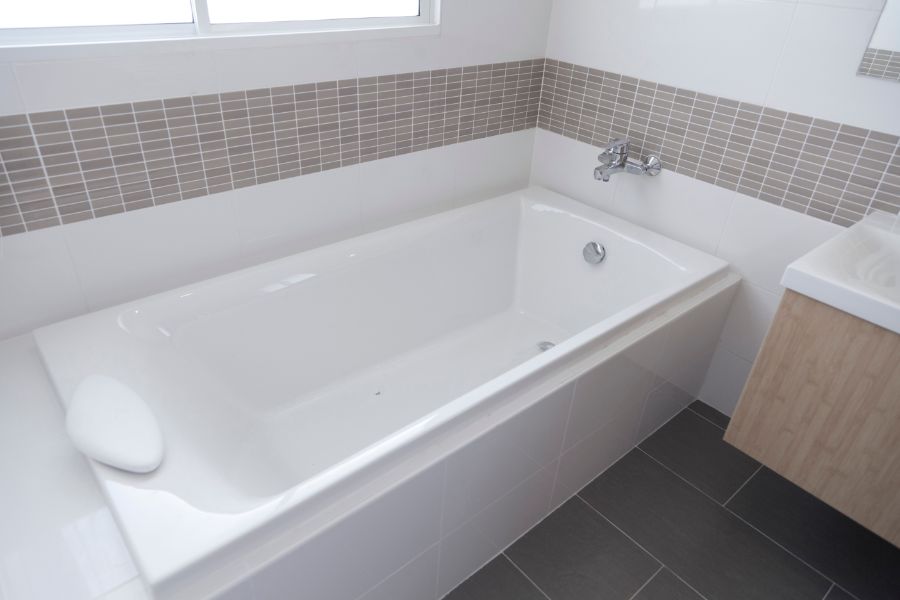Porcelain tubs are a classic choice for bathrooms and for good reason. Their glossy finish and elegant design have a timeless appeal that transcends trends. It is a type of ceramic that is fired at high temperatures, has a non-porous surface that is resistant to staining and easy to clean. This makes it an ideal material for bathtubs, offering both functionality and beauty.
Table of Contents
Porcelain Tubs: A Versatile Choice for Any Bathroom Style
One of the reasons porcelain tubss have remained a popular choice over the years is their versatility. Whether you’re designing a modern, minimalist bathroom or going for a more traditional, vintage look, a porcelain tub can fit right in.
In a modern bathroom, a sleek, freestanding bathtub made of porcelain can serve as a striking centerpiece. Its clean lines and glossy finish complement the minimalist aesthetic, while its classic material adds a touch of warmth and comfort.
For a traditional or rustic bathroom, a porcelain clawfoot bathtub can add a touch of nostalgia and charm. The glossy white surface of the tub contrasts beautifully with natural materials like wood and stone, while the ornate feet add a touch of elegance.

The Impact of Color and Finish on Your Bathroom’s Aesthetics
The typical color of porcelain is white, sometimes its beige, which is a versatile choice that can fit into any color scheme. Anything near white can brighten up the bathroom and make it feel more spacious. It also provides a neutral backdrop that allows other elements in the bathroom, such as tiles or fixtures, to stand out.
The glossy finish of a porcelain tub adds to its aesthetic appeal. It reflects light, adding a sense of depth and dimension to the bathroom. The smooth, shiny surface is also pleasing to the touch, adding to the overall bathing experience.
However, bathtubs made of porcelain are not limited to white. They can be found in a variety of colors, from soft pastels to bold hues. A colored tub can serve as a statement piece in the bathroom, adding a pop of color and personality.
Shapes and Designs: Adding Character to Your Bathroom
Porcelain tubs come in a variety of shapes and designs, each with its own aesthetic appeal. The classic clawfoot bathtub, with its curved sides and ornate feet, has a vintage charm that can add character to any bathroom. On the other hand, a modern, freestanding bathtub with straight lines and a rectangular shape can add a touch of sophistication and modernity.
The shape and design of the bathtub can also affect the functionality of the bathroom. For example, a deep, freestanding tub can provide a luxurious soaking experience, while a tubs with a wider rim can provide space for bath products or even a place to sit.
Porcelain vs. Other Materials: A Battle of Aesthetics
When it comes to bathroom remodeling, the choice of bathtub material is crucial. While porcelain is a popular choice, other materials like acrylic and cast iron also have their merits. However, in terms of favorites, porcelain often takes the lead.
Acrylic bathtubs, while lightweight and affordable, lack the glossy finish and substantial feel of porcelain. They may not have the same level of sophistication, but their versatility and wide range of colors and styles make them a popular choice for modern bathrooms.
Cast iron bathtubs, on the other hand, offer a similar level of elegance and durability as porcelain. They retain heat well, making for a warm, relaxing bath. However, they are significantly heavier and may require additional support in your bathroom floor.
In the end, the choice comes down to personal preference. If you value a classic, elegant look and a durable, easy-to-clean surface, a porcelain tub might be the perfect fit for your bathroom.

Keeping Your Porcelain Tub Pristine
Maintaining the beauty and quality of a bathtub, specifically a porcelain one, is straightforward with regular care. Due to its non-porous surface, stains and dirt can be easily wiped away. A simple mixture of warm water and mild dish soap is usually enough to keep your bathtub sparkling clean. Avoid using abrasive cleaners or scouring pads, as they can scratch the surface and dull the glossy finish.
Over time, porcelain is prone to develop minor chips or cracks. These can be repaired using a porcelain repair kit, which includes a filler and a glaze that can be color-matched to your tub. Regular maintenance and prompt repair of any damage can keep your porcelain tub looking its best for years to come.
Porcelain Tubs: A Blend of Comfort and Style
The shape and design of porcelain tubs not only contribute to their aesthetic appeal but also to their comfort. The smooth, glossy surface is comfortable against the skin, and the material retains heat well, allowing for a warm, relaxing bath. Whether you prefer a deep soaking tub or a bathtub with a wider rim for lounging, there’s a porcelain bathtub design to suit your comfort needs.
Elevate Your Bathroom with a Porcelain Tub
In conclusion, porcelain bathtubs offer a timeless aesthetic appeal that can enhance any bathroom style. Their glossy finish, versatile color options, and variety of shapes and designs make them a popular choice for bathroom remodels. With proper care, a porcelain bathtub can remain a beautiful centerpiece in your bathroom for many years.
Frequently Asked Questions About Bathtubs
What are the different types of bathtubs?
There are several types of bathtubs – freestanding , alcove, drop-in, corner, and walk-in types. Each type has its own unique features and is suitable for different bathroom layouts and styles.
What materials are they made from?
Bathtubs can be made from a variety of materials, including acrylic, porcelain, fiberglass, and stone resin. Each material has its own pros and cons in terms of durability, maintenance, and aesthetic appeal.
How do I clean a bathtub?
Most bathtubs can be cleaned with a mixture of warm water and a mild detergent. Avoid using abrasive cleaners or scouring pads, as they can scratch the surface of the tub. For stubborn stains, a baking soda and water paste can be effective.
How long does a bathtub last?
The lifespan of a bathtub depends on the material it’s made from and how well it’s maintained. On average, bathtubs last between 10 to 15 years. However, some materials like cast iron and porcelain can last much longer with proper care.
How much does a bathtub cost?
The cost of a bathtub can vary widely depending on the type, material, and size. On average, you can expect to pay anywhere from $200 for a basic acrylic tub to over $2,000 for a high-end freestanding tub.
What size bathtub should I get?
The size should depend on the size of your bathroom and your personal preferences. Standard bathtubs are usually 60 inches long and 30 to 32 inches wide, but there are also smaller and larger options available.
Can I install a bathtub myself?
While it’s possible to install a bathtub yourself, it’s usually recommended to hire a professional. Bathtub installation can be a complex process that involves plumbing and sometimes electrical work, so it’s best left to the experts.
How do I choose the right bathtub for my bathroom?
When choosing a bathtub, consider the size of your bathroom, your budget, and your personal preferences. Think about how you plan to use the tub, the style of your bathroom, and the material and type of tub that best suits your needs.
